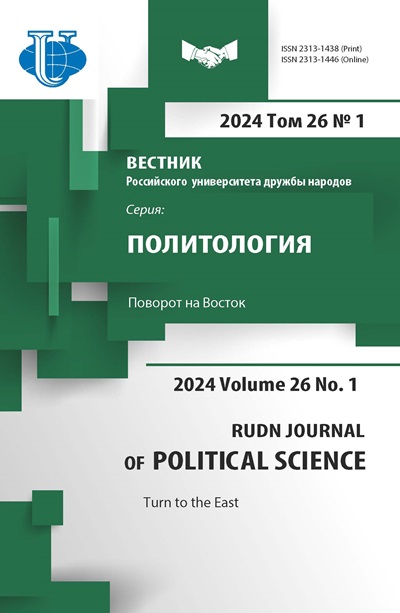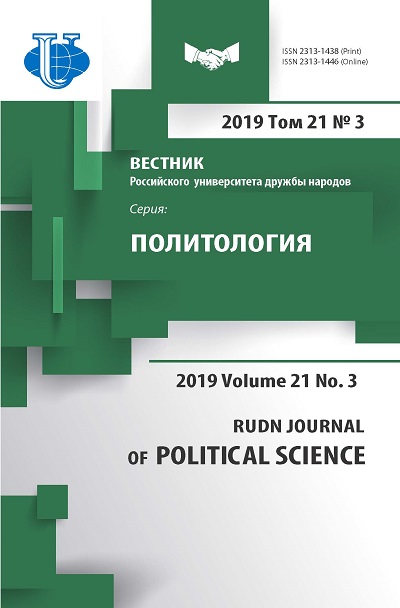Theda Skocpol’s Theory of Revolution
- Authors: Shults E.E1
-
Affiliations:
- Moscow State Regional University
- Issue: Vol 21, No 3 (2019)
- Pages: 503-512
- Section: Some actual problems of political science
- URL: https://journals.rudn.ru/political-science/article/view/22060
- DOI: https://doi.org/10.22363/2313-1438-2019-21-3-503-512
Cite item
Full Text
Abstract
The article analyzes several ideas suggested by American political scientist Theda Skocpol in regards to the theory of revolution. From the author’s point of view, Skocpol’s attitudes are noteworthy both in terms of studying the history of political science and understanding the current state of “the theory of revolution” as a scientific direction. The author critically examines the classification of “generations of the theory of the revolution contributors” offered by J. Goldstone, according to which T. Skocpol belongs to “the third generation”. At the same time, the key provisions of Skocpol’s concept continue the ideas of the first and second generations, as is suggested by Goldstone. The author highlights the importance of the conceptual provisions related to the questions of social system failures and the reasons and consequences of revolutions in the context of revolutionary modernization.
About the authors
Eduard E Shults
Moscow State Regional University
Author for correspondence.
Email: nuap1@yandex.ru
PhD in History, Director of the Center for Political and Social Technologies
Moscow, Russian FederationReferences
- Goldstone J. To the Theory of Revolution of the Fourth Generation. Logos. 2006; 5: 58—103 (In Russ.).
- Gryaznova O.S. Theda Skocpol: A Revolution Phenomenon in Structuralist Prospect. Person. Community. Management. 2007; 4: 21—38 (In Russ.).
- Gryaznova O.S. Theoretical Approaches in Sociology of Revolution: Comparative Analysis of Concepts of P. Sorokin, L. Edwards and T. Skocpol. Dissertation, PhD in Social Sciences. Moscow; 2009. 186 p. (In Russ.).
- Shults E.E. Theory of Revolution of Jack Goldstone. Bulletin of the Moscow State Regional University. Series: History and political sciences. 2018; 3: 171—182 (In Russ.).
- Shults E.E. The Theory of Revolution of Marx in the Context of Social Thought of the 19th Century in Europe. Management Issues. 2014; 2: 32—42 (In Russ.).
- Shults E.E. Theory of Revolution: Revolutions and Modern Civilizations. Moscow: LENAND; 2016. 400 p. (In Russ.).
- Eisenstadt S.N. Revolution and the Transformation of Societies: A Comparative Study of Civilizations. Moscow: Aspekt Press; 1999. 416 p. (In Russ.).
- Arendt H. On Revolution. N.Y.: Viking Press; 1963. 350 p.
- Brinton С. The Anatomy of Revolution. Revised and Expanded Edition. N.Y.: Vintage Books; 1965. 310 p.
- Calvert P. A Study of Revolution. Oxford: Clarendon Press; 1970. 249 p.
- Calvert P. Revolution. London: Praeger; 1970. 174 p.
- Dunn J. Modern Revolutions: An Introduction to the Analysis of a Political Phenomenon. Cambridge University Press; 1972. 350 p.
- Eisenstadt S.N. Revolution and the Transformation of Societies: A Comparative Study of Civilizations. N.Y.: Free Press; 1978. 348 p.
- Ellul J. Autopsy of Revolution. N.Y.: Knopf; 1971. 300 p.
- Foran J. Revolutions. The Blackwell Encyclopedia of Sociology. Ed. by G. Ritzer. Blackwell Publishing; 2007: 3914—3923.
- Foran J. Taking Power. On the Origins of Third World Revolutions. Cambridge University Press; 2005. 395 p.
- Gilman N. Mandarins of the Future: Modernization Theory in Cold War America. Baltimore — London: The Johns Hopkins University Press; 2003. 329 p.
- Goldstone J.A. The Comparative and Historical Study of Revolutions. Annual Review of Sociology. 1982; 8: 187—207.
- Goldstone J.A. Theories of Revolution: The Third Generation. World Politics. 1980; 32 (3): 425—453.
- Goldstone J.A. Towards a Fourth Generation of Revolutionary Theory. Annual Review of Political Science. 2001; 4: 139—187.
- Gurr T.R. Why Men Rebel? Princeton, N.J.: Princeton University Press; 1970. 421 p.
- Hagopian M.N. The Phenomenon of Revolution. N.Y.: Dodd, Mead; 1975. 402 p.
- Huntington S.P. Political Order in Changing Societies. New Haven: Yale University Press; 1968. 488 p.
- Inglehart R., Welzel C. Modernization, Cultural Change, and Democracy: The Human Development Sequence. Cambridge University Press; 2005. 333 p.
- Johnson C. Revolutionary Change. Stanford University Press; 1982. 217 p.
- Johnson Ch. Revolution and the Social System. The Hoover Institute of War, Revolution and Peace. Stanford University Press; 1964. 69 p.
- Jouvenel B. On Power. Its Nature and the History of Its Growth. Boston: Beacon Press; 1962. 421 p.
- Kimmel M.S. Revolution. A Sociological Interpretation. Philadelphia: Temple University Press; 1990. 252 p.
- Meisel J.H. Counterrevolution: How Revolution Die. N.Y.: Atherton Press; 1966. 237 p.
- Rejai M. The Comparative Study of Revolutionary Strategy. N.Y.: McKay; 1977. 194 p.
- Rejai M. The Strategy of Political Revolution. N.Y.: Doubleday & Company; 1973. 189 p.
- Revolution: Yearbook of the American Society for Political and Legal Philosophy. Ed. by C.J. Friedrich. N.Y.: Atherton Press; 1966. 246 p.
- Skocpol T. States and Social Revolutions. A Comparative Analysis of France, Russia and China. Cambridge University Press; 1979. 407 p.
- Skocpol T., Trimberger E.K. Revolutions and the World-historical Development of Capitalism. Social Revolutions in the Modern World. Cambridge University Press; 1994: 120—132.
- Stone L. The Causes of the English Revolution, 1529—1642. London — NY: Routledge; 2005. 185 p.
- Stone L. Theories of Revolution. World Politics. 1966; Vol. XVIII; 2: 159—176.
- Tilly C., Tilly L., Tilly R.H. The Rebellious Century, 1830—1930. Harvard University Press; 1975. 354 p.
















